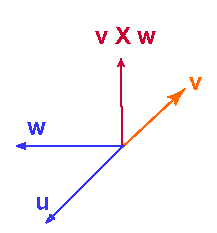Not Associative

Fussing with math gives the same result:
| (ku) × v | = | ku | | v | sin θ = | k | |u | | v | sin θ
The magnitude is | k | times the magnitude of u × v. And the orientation of the result must be the same. So the answer is correct.
Another fact is that, in general, (u × v) × w =/= u × (v × w)
To see this, look at the diagram and mentally form the cross product
